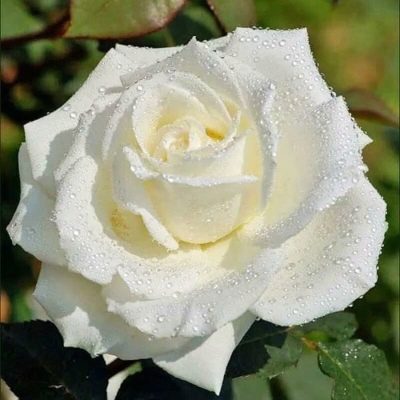
- Authors: Terra Nigra
- Name synonyms: White chocolate
- Breeding year: 2016
- Group: tea-hybrid
- The main color of the flower: white, cream
- Flower shape: cupped
- Flower size: large
- Diameter, cm: 10-12
- Flower type by number of petals: thick double
- Description of the bush: compact, with vertical shoots
White roses have always been very popular among gardeners and are considered especially beautiful. Rose White Chocolate is distinguished by its delicious appearance, easy care and the ability to grow in any climatic conditions. Even a beginner is able to grow a bush on his site.
Description of the variety
The variety was created in 2016 by the company from the Netherlands Terra Nigra. Specialists have created a cut variety of hybrid tea roses, which does not lose its appearance when cut within 2-3 weeks.
Despite the fact that White Chocolate belongs to the snow-white varieties, in fact, this is not entirely true. The main color of the petals is creamy white, reminiscent of baked milk, only towards the middle of the buds, due to the high density, the shade becomes close to white chocolate. The color saturation is pale, there is no variegation.
The shape of the buds is classic, cup-shaped. The size of the flowers is quite large - 10-12 cm in diameter. A large number (45-55 pieces) of large petals create a densely doubled flower. As a rule, 1 bud is formed on one stem, less often several in inflorescences. The aroma of the plant is weak.
Bushes grow compact, with erect shoots. On average, the height of the bush is 100-120 cm and the width is 50-60 cm. This variety is popular not only for its very beautiful appearance, but also for the almost complete absence of thorns on the shoots.
Advantages and disadvantages
Advantages:
high decorative properties;
resistance to low temperature indicators and fungal diseases;
long continuous flowering, up to the first frost;
perfectly withstands both a dry period and an abundance of rains.
Disadvantages:
the flower has practically no aroma;
the buds never fully open.
Flowering features
The White Chocolate rose blooms very profusely, which continues throughout the season, until the first frost. Shrubs are covered with elegant buds due to re-flowering.
Landing
Before planting this variety on your site, you should carefully choose a place for it. The site must be sunny and protected from drafts. Better if you plant a rose near a fence, hedge or house. The plant prefers to grow in slightly acidic soils, with good air permeability and sufficient nutrients. And also when planting, the distance between the bushes should be taken into account, which should be at least 100 cm.
Growing and care
The best option for cultivating rose bushes is to plant seedlings. However, the planting material must also be chosen correctly. Then the bushes will take root well and will not hurt in the future. It is preferable to choose roses with a closed root system. But if such seedlings cannot be purchased, then before planting the plant, it is left for several hours in warm water.
For 1 sq. m have no more than 4 bushes. The hole is made up to 50 cm deep, the volume of the roots is taken into account. A drainage layer, a nutritious soil mixture with fertilizer is placed on the bottom. The root collar should be 3-4 cm below ground level. After the seedling is poured abundantly with settled water, rammed and laid a layer of mulch.In order for the rose to take root better, after planting it is better to water it with water and a solution that stimulates root formation.
Care consists in basic procedures: watering, feeding, loosening, disease prevention, shelter for the winter, sanitary pruning. The first year after planting, rose bushes are not allowed to bloom, the buds must be plucked so that the plant does not waste its energy on flowering.
Watering and feeding
Rose is a moisture-loving culture that requires regular and abundant watering, as well as frequent feeding. Drying out of the soil is unacceptable. The plant especially needs irrigation during the period of active growth and flowering. But you should not allow stagnation of water in the roots. Watering is regulated depending on weather conditions.
The health and abundance of flowering largely depend on the regularly applied top dressing. In the first year of planting, additional food is not needed for the bushes, the one that was added to the planting hole is enough. In autumn before winter, the plant is fed with potash fertilizers.
In the second year of growth, in the spring, the bushes are fertilized with nitrogen-containing substances. With the beginning of intensive flowering in late June - early July, the rose must be fed with a phosphorus-potassium complex.
Pruning
The main purpose of pruning is the sanitary purpose and shaping of the bushes, which is carried out in the spring (the frozen shoots are removed) and in the fall (the damaged, unripe and diseased branches are cut off).
To form bushes, pruning is carried out 3 times per season. In the spring, tall shoots are cut to 8 buds, undersized to 4. Shoots on which flowering took place are shortened. In the fall, the general shape of the bush is corrected.
Frost resistance and preparation for winter
Despite the fact that the variety is highly frost-resistant (the plant can withstand a drop in temperature from –18 ° C to –23 ° C), partial shelter is required. For this, the bushes are covered with agrofibre or spruce branches.































































